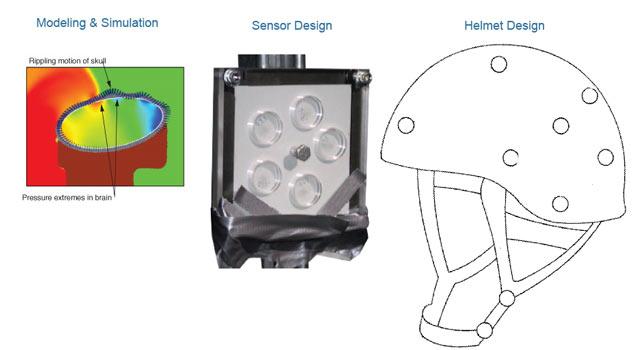The cost of treating traumatic brain injury (TBI) is estimated to run into billions of dollars in the future. To date, the majority of research targeted at understanding and mitigating TBI has focused on impact (blunt trauma), where the duration and magnitude of the acceleration imparted by the impact are typically used to predict damage. However, in some environments, blasts can be a significant contributor to TBI. Using LLNL modeling methods a new mechanism was discovered that may contribute significantly to the generation of blast-induced traumatic brain injury. Current protection systems, e.g., helmets, are designed primarily to protect against various forms of debris and shrapnel, not blast. Leveraging LLNL modeling methods and understanding of this new mechanism could contribute to the design of protective equipment that better protects against blast without sacrificing its effectiveness against other threats.
The goal of a partnership is to design the next generation of protective equipment against blast. The research will use LLNL's expertise in pressure sensor design and high fidelity modeling methods which have generated new understanding of the mechanisms that contribute to blast-induced brain trauma.
LLNL's high fidelity hydrocode is capable of predicting blast loads and directly coupling those loads to structures to predict a mechanical response. By combining this code and our expertise in modeling blast-structure interaction and damage, along with our access to experimental data and testing facilities, we can contribute to the design of protective equipment that can better mitigate the biological effects of blast.
LLNL has investigated two types of sensors to quantify the blast environment, which will help medical personnel diagnose the severity of injuries and triage patients. Both sensor designs are small and lightweight. One new sensor uses a tiny microelectromechanical gauge and the other is an inexpensive, disposable, and easily replaceable plastic cylinder. Each sensor contains a paper that changes color when exposed to specific levels of pressure.
More information can be found in a Science & Technology Review article and an LLNL press release.
New understanding of how blast can contribute to brain trauma provides a pathway for improving helmet systems and other protective equipment, and designing vehicles or structures to enhance the protection of their occupants from blast. Better designs for protective equipment and vehicles would result in fewer casualties from TBI, improved operational effectiveness, and reduced costs associated with veterans' treatment. There is also the potential to provide criteria, or even sensing devices, for identifying when blast victims might require immediate medical intervention, independent of what they self-report, and therefore save lives.
The principal goal is to develop personal or vehicular armor systems that provide better protection from blast effects, so the primary commercial users will be the military and civilian protective forces. However, there are also potential applications other industries:
- Athletic equipment
- Mining
- Construction



